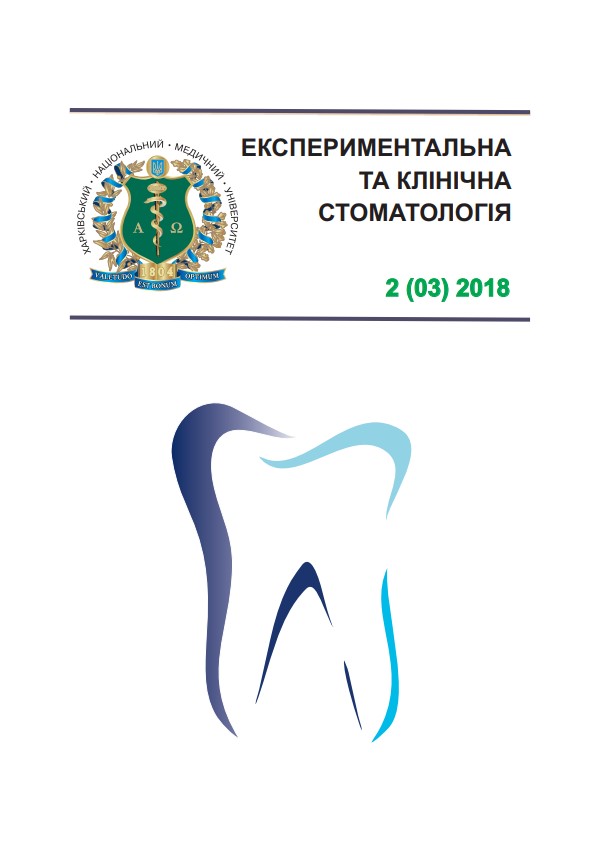Abstract
Introduction. The success of implantation in many respects determines the correct determination of the indications for carrying out this type of rehabilitation measures, the choice of the implant design, the technique of the surgical intervention, the period of restorative treatment and the system of preventing complications. The existing ways to reduce the number of visits and reduce the overall duration of treatment is immediate implant placement. In such situations, both basal single-stage and classic two-stage intraosteal implants can be used.
The use of the method of one-stage implantation allows to preserve the volume of bone tissue in the zone of the removed teeth. The frequency of development of inflammatory phenomena in the postoperative period decreases.
Minimizes the number of operations and their traumatism.
The aim of the work is to analyze the long-term results of the direct dental implantation method.
Objects and methods. A total of 54 patients aged 25 to 55 years who underwent direct dental implantation on the lower or upper jaws (one or two implants within a single segment) were treated in a complex manner. The criteria for including patients in the study were: secondary adentia.
Immediate dental implantation was carried out in strict compliance with all stages of this type of rehabilitation of patients with partial secondary adentia. The removal of the destroyed tooth was made, the socket of the removed tooth was formed with mills of increasing diameter, an implant was installed and a temporary artificial crown was immediately produced.
The characteristics and structure of bone tissue, were evaluated based on the data of the radial methods of the study (cone-beam computed tomography (CBCT) of the jaws or orthopantomograms (OPTG). In the following, with the aim of dynamic evaluation of the implant osteointegration, the radiation methods of the study were carried out.
An important role was given to the state of hygiene, the presence of dental plaque in the area of the implant, which is associated with the development of local inflammation in the form of mucositis and peri-implantitis. After the installation of orthopedic structures with support for dental implants, the functional state of the latter was assessed: the distribution of the load on the implant, the occlusal load during chewing, and the aesthetic state of the artificial crown, its color and shape, the degree of erosion, discoloration, and chipped crowns.
The results. Radiation methods of research showed that the incidence of single defects in the dentition was 53.5 % at the age of 36–55 years; 37.1 % at the age of 33–35 and 9.4 % at the age of 24–32.
The structure of bone tissue on the upper jaw in the frontal region and in the region of absent premolars included type 3 in 13 patients; in the lateral parts of the jaw the 4th type was determined in 3 patients. On the lower jaw in the frontal department of type 1 was in 2 patients, in the region of absent premolars and molars, the second type of bone tissue was detected in 14 patients. All implants were osteointegrated, bone tissue uniformly adhered to the entire surface of the implants, and pathological resorption of bone tissue was absent.
The conclusion. Motivation, individual selection of hygiene products and training in the methods of their use is a prerequisite for maintaining a good hygienic state of the oral cavity and preventing possible complications of the treatment.
The method of direct two-stage installation of the dental implant is shown in those situations when the level of the gum is preserved, there is no atrophy of the alveolar margin, the mucosa is not thinned. There are no clinical signs of a pathological process in the periapical zone. The method of direct one-stage implant placement is shown immediately after the removal of the tooth, which had no clinical signs of inflammation in the surrounding tissues, without radiologic changes in the bone structure of the bone tissue in the region of the apex of the root and if the patient wishes to conduct all the interventions in one visit.
Keywords: direct dental implantation, osseointegration, radiation methods.
References
Burrows R.S. Risk factors in implant treatment planning / R.S. Burrows // European Journal for Dental Implantologists. – 2013. – V. 1. – P. 74–79.
Hall J. A controlled, cross-sectional exploratory study on markers for the plasminogen system and inflammation in crevicular fluid samples from healthy, mucositis and periimplantitis sites / J. Hall // Eur. J. Oral Implantol. – 2015. – V. 2. – P. 153–166.
John A. Hobkink. Introducing Dental Implants / John A. Hobkink, Roger M. Watson, Lloyd S.S. Searson. – London: Churchill Livingstone, 2010. – Р. 70–78.
Miguel de Ara jo Nobre. Risk factors of peri-implant pathology / Miguel de Ara jo Nobre, A. Mano Azul, E. Rocha, P. Mal // European Journal Oral Sciences. – 2015. – 123 (3). – P. 131–139.
Shatkin T.E. Mini dental implants: awestora specanalysis of 5640 implants placed a 12-years period / T.E. Shatkin, C.A. Petrotto // Compend Contin Educ Dent. – 2012. – Vol. 33, Spec. 3. – P. 2–9.

